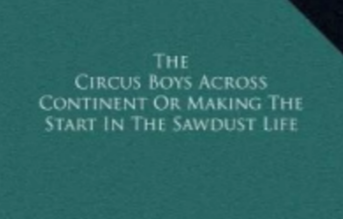CHAPTER II — The Circus Boys Across the Continent
byCHAPTER II — The Circus Boys Across the Continent begins with a scene full of color, movement, and organized chaos as the Great Sparling Combined Shows prepare to depart their winter quarters. The atmosphere is filled with shouting crew members, restless animals, and clanging equipment being loaded onto trains. Amidst the rush, Phil Forrest and Teddy Tucker navigate the hustle with a mixture of excitement and uncertainty, trying to find their place in this new rhythm. Their reunion with fellow performer Rodney Palmer brings some comfort and familiarity. Rodney, having spent the winter performing in vaudeville, is surprised to learn the boys were in school instead. Their choice is questioned, but it’s clear their return to the circus is welcomed and appreciated by their peers.
The conversation with Rodney also leads to practical concerns—namely, where they will be sleeping and how they’ll fit into the traveling show’s new season. Not entirely sure about the arrangements, Phil and Teddy decide to find Mr. Sparling, the circus owner, who can clarify things. They are met with the expected sharp tongue and commanding presence of a seasoned showman. Mr. Sparling’s dry wit and firm tone leave little doubt that he values discipline and professionalism among his performers. Despite his gruff demeanor, his handshake signifies trust and acceptance, reinforcing the sense of belonging the boys feel in this unconventional family. Their confidence is quietly restored, and they begin to mentally prepare for the demands of the season ahead.
Boarding the sleeper train marks another turning point in their journey, as it introduces them to the odd but functional setup of circus travel. A converted railcar serves as their new living quarters, complete with bunk beds and narrow hallways. Their interaction with the porter, who seems unimpressed by Teddy’s animated behavior, provides a moment of lightheartedness. Even in unfamiliar surroundings, the boys manage to find humor and camaraderie in every moment. This environment, while strange, feels alive and buzzing with potential. The novelty of sleeping on a moving train becomes a small adventure in itself. They know their journey has only just begun.
But not everything goes smoothly. Teddy’s energetic nature and impulsive desire to take charge quickly get him into trouble when he tries to direct the laborers loading equipment. His actions draw annoyed glances, and before long, he’s in a tense encounter with a seasoned roustabout. Words are exchanged, and in typical Teddy fashion, the situation escalates into a scuffle. Using his circus acrobatics and quick thinking, Teddy wriggles free and turns the situation into an impromptu performance, flipping and dodging with showman flair. His mischievous antics don’t go unnoticed, though, and a few crewmembers grumble about the boy’s overconfidence. Still, his creativity and fearlessness win the grudging respect of some.
The mood shifts when Teddy, after narrowly escaping another round of confrontation, realizes that the sleeper car carrying Phil and the rest of the circus troupe has departed without him. Panic sets in, but he quickly pulls himself together, knowing the show must go on—with or without him. Determined not to be left behind, he sprints toward a different train and, in a move that would impress even the most daring performer, leaps aboard. It’s a bold and risky decision, but one that feels true to Teddy’s character. His physical courage and loyalty to the circus push him to face danger rather than accept separation. That leap captures more than just distance—it symbolizes his commitment to this traveling life.
What stands out in this chapter is how quickly the circus world tests its newcomers. There’s no time to ease in; everything is in motion, and decisions must be made on the fly. For young performers like Phil and Teddy, that pressure becomes a part of their growth. Readers are shown that while circus life may appear glamorous, it’s full of challenges that demand maturity, courage, and fast thinking. The mix of humor, conflict, and genuine emotion keeps the narrative grounded and relatable. This is not just a children’s adventure—it’s a story about finding one’s role within a fast-paced, ever-changing world.
Beyond the adventure, this chapter also introduces young readers to the realities of teamwork and self-control. Teddy’s missteps highlight the importance of knowing when to lead and when to follow. His intentions aren’t wrong, but his execution needs refining. That lesson is not scolded into him, but learned through consequences and reflection. Phil, by contrast, acts more cautiously, serving as a steady counterbalance to Teddy’s impulsiveness. Together, they reflect the dual nature of youthful energy—one driven by boldness, the other by thoughtfulness. It’s a dynamic that will likely define many of their future encounters on the road.
There’s also an unspoken message in how the circus responds to conflict. Rather than punishing every mistake harshly, the crew members recognize effort, spirit, and growth. Respect isn’t given freely, but it can be earned—even by a troublesome but talented boy like Teddy. The circus becomes more than a stage; it’s a place where discipline, friendship, and learning happen side by side. For readers following the journey, this chapter delivers not only action and laughter but a deeper appreciation for how unique communities operate. Every train whistle and tent rope carries the weight of stories, lessons, and endless possibilities.

